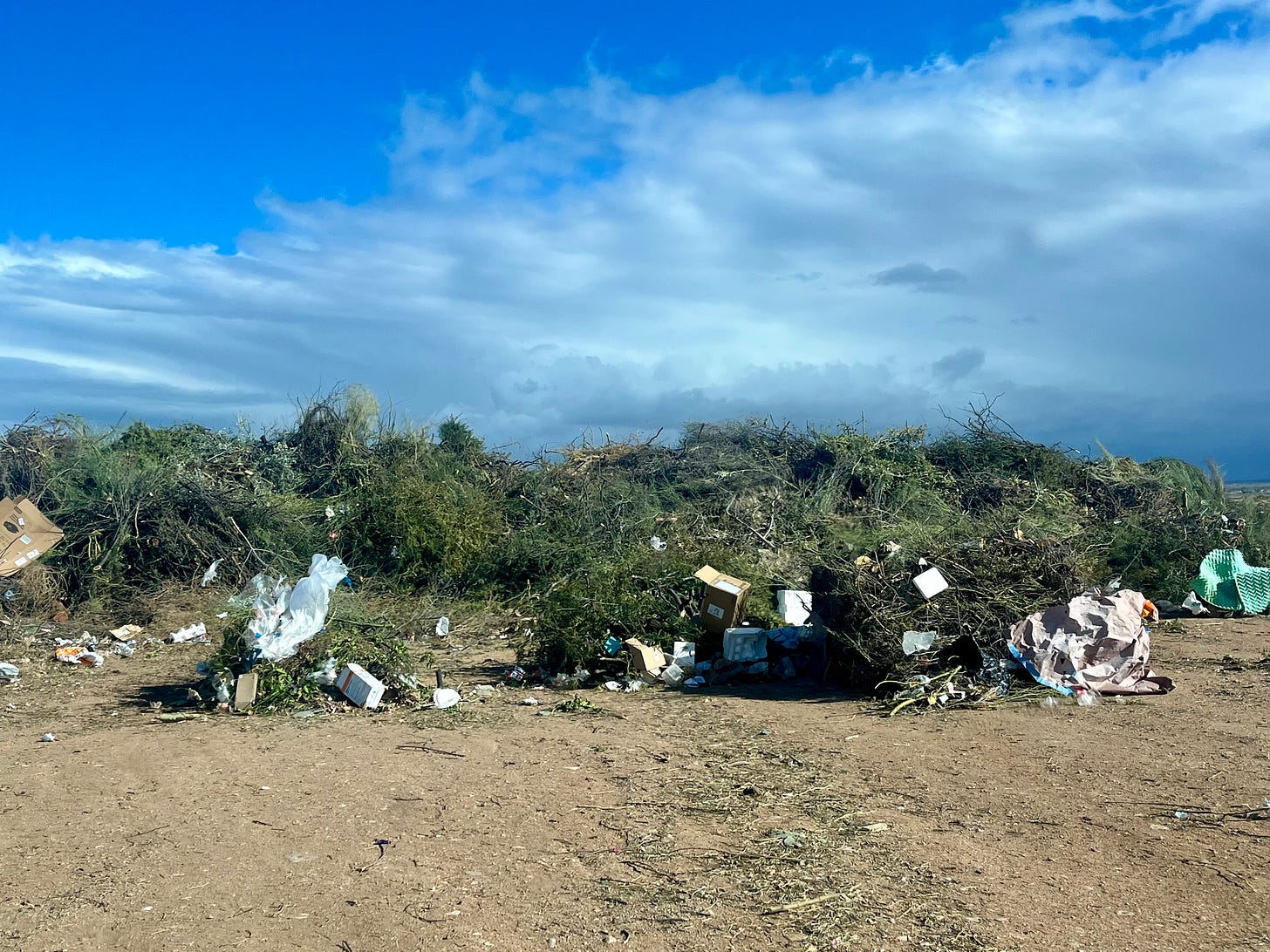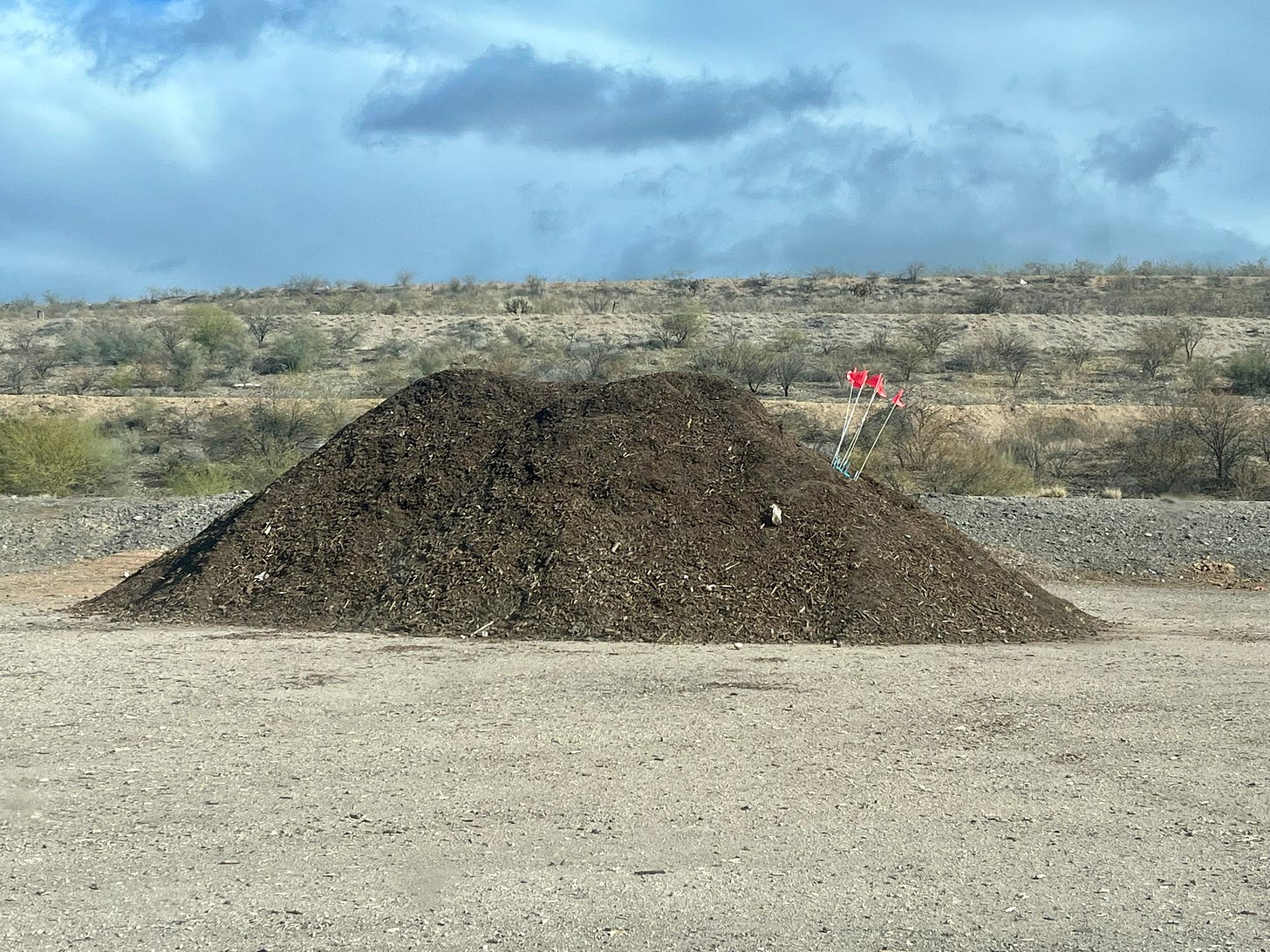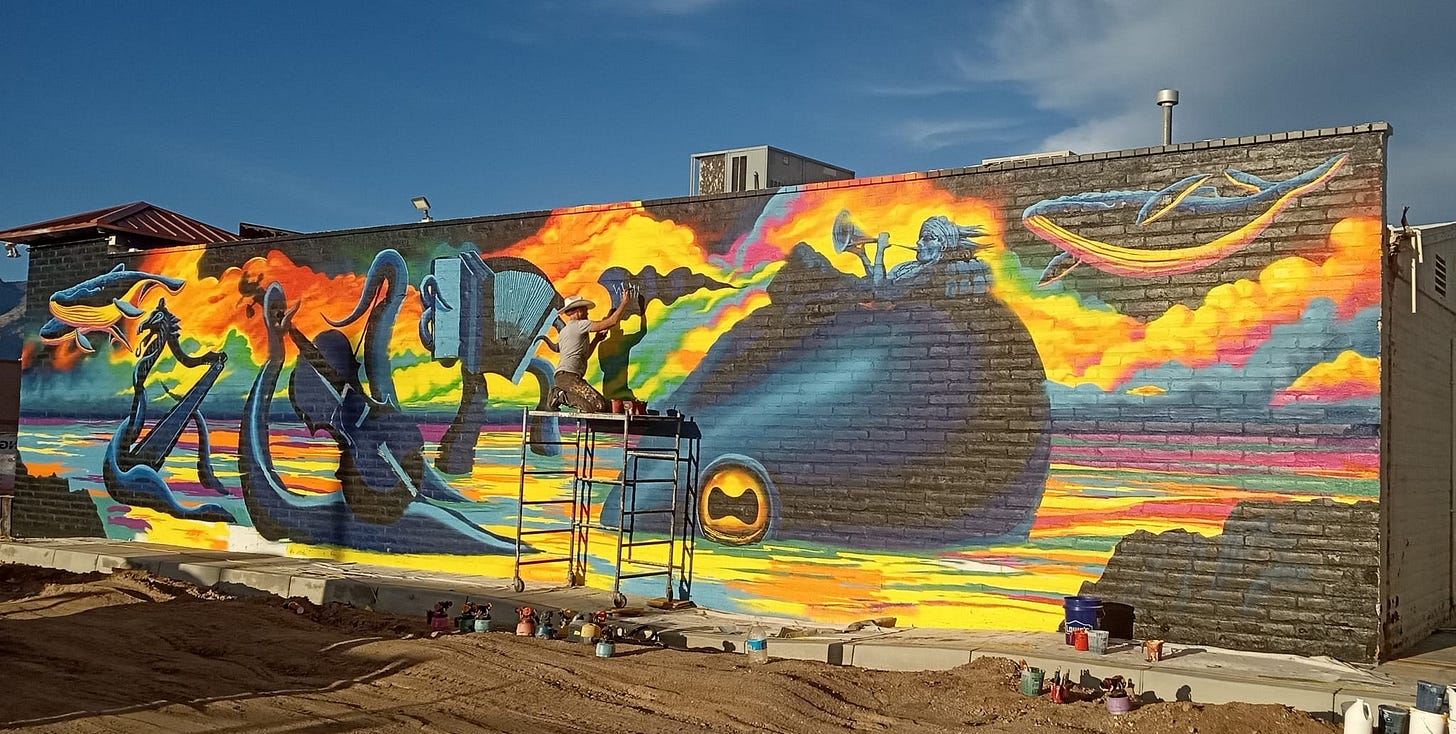The Climate Agenda: Checking in on Tucson's sustainability campus
Three years ago, the city rebranded its landfill as a sustainability campus ... Now, Los Reales is home to several projects that reuse, repurpose and divert waste ... TUSD keeps diversity department.
We’ve been experimenting with new formats and today we’re launching a regular feature that will highlight climate and sustainability-related efforts.
In addition to climate-related stories, you’ll also find a special section about ways to get involved, including community events, public meetings and more.
We already have a running story list for future editions, but we’d love to hear your ideas. Send those to caitlin@tucsonagenda.com.
Three years ago, the city rebranded its Los Reales Landfill as a sustainability campus, part of its plan to divert half of the city’s waste by 2030 and be waste-free by 2050.
Achieving zero waste seems like a monumental task. In 2021, 764,000 tons of waste ended up in the city’s landfill.
But city officials are committed to the goal and have been working hard to create new programs and processes. These include a plastic reuse program, expanded composting availability and adding to the city’s tree canopy.
Many of these efforts centered at Los Reales Sustainability Campus. And while it still includes a landfill that takes in plenty of waste, there are now several other projects focused on reducing, repurposing and creating resources.
On a recent and very windy Thursday, Caitlin took a tour of the sustainability campus. And even though the city’s plastic reuse program is diverting several tons of single-use plastics every week, the ones that had made their way to Los Reales were wreaking havoc.

It was impossible not to notice the accumulation of bags and plastic film clinging to the chain link fence that lines eastbound Interstate 10 at the Craycroft Road exit. On the campus itself, every gust of wind sent pieces of plastic twirling through the air, floating reminders of the throwaway culture that society is struggling to correct.
But beyond the bags, it was also impossible not to notice all that’s changed at Los Reales and the shifted focus to reducing landfill waste.
One of the most recent changes is the expansion of the city’s FoodCycle program, which started as a partnership between the city and the University of Arizona Compost Cats. Until a few months ago, the program was only available for use by restaurants, grocery stores and other commercial operations.
FoodCycle at Home brings the program to households and individuals. After taking a 30-minute training, participants receive a home collection bin for food scraps, which they will then drop off at one of six city collection sites (all of which are located at community gardens.) The city will collect the waste, process it as compost and eventually return it to the community gardens.
“It just completes the full circle of that organics recycling,” said Environmental Specialist Jose Garcia.

More than 300 people have attended training sessions that teach them about what can and cannot go into bins and give them the opportunities to ask questions. The first two loads that came into Los Reales from the residential program each weighed in at around 400 pounds.
“This is a pilot program, so there’s room for improvement and feedback,” said Public Information Specialist Alyssa Tarpley. “People want accessibility. And we want to expand the number of sites and we want to expand the number of people.”
While there are no more training scheduled on the calendar yet, the city will be adding more and is looking into possibly adding a virtual training option.
Los Reales doesn’t just process food waste. It also takes in about four tons each week of “zoo doo,” through a year-old partnership with Reid Park Zoo. The zoo brings in waste from animals with plant-based diets and Los Reales turns it around.
On the subject of plants, the most recent addition to the campus is the launch of a green waste pilot program that now diverts tree limbs, cactus, palm branches, brush and more from the landfill.
“Our landfill, every single day we see an average of 2,700 to 3,000 tons of trash. I’d easily have to say about 50% of that is green waste,” Garcia said. “That’s one of our biggest targets at the moment.”
The program is open to residents and landscapers, and the mulch created from the green waste will help to fuel the campus’ composting facility. It will also be used for landfill repairs and the creation of stormwater infrastructure, but the city would eventually like to make it available to the community.

The campus isn’t just home for discarded greens, it also has a tree nursery where Tucson Clean and Beautiful stores seedlings as they mature. The trees are watered and when they’re big enough, eventually deployed around Tucson as part of the city’s Million Tree Initiative.
And in the true spirit of reusing, the city has started to repurpose landfill waste by using treated groundwater for dust mitigation and soon, refining landfill gas into renewable natural gas. The city is in the process of looking for a developer to facilitate the process.
The refined gas will be injected into a pipeline for primary use by the transportation energy. The gas will also be used to fuel the city’s buses and residential trash trucks, which are powered by compressed natural gas.
City officials are looking to bring other sustainability measures to the Los Reales campus, and are exploring ways to divert construction demolition and debris from the landfill. They’re also talking about creating a reuse boutique, where items that would otherwise end up in the landfill are instead sold as reusable goods.
“The past decade or so, a lot of the public education has been about recycling. Now it’s really shifting to reducing and waste diversion,” Tarpley said. “The goal is to preserve the landfill life and kind of get Tucson residents thinking about ‘My food waste is now a resource to use in composting’ or ‘Maybe I shouldn’t get this plastic straw.’ It’s not just recycling anymore.”
Keeping it free: Tucson officials are worried the University of Arizona’s financial troubles mean the university won’t help fund fare-free transit, KOLD’s Bud Foster reports. UA students are big-time users of city transit, which the Tucson City Council made free to all during the COVID pandemic. Council members have spent months hoping the UA will partner with them to keep transit free after federal COVID money runs out. That hope is dimming, they said, now that the UA is struggling.
Not just yet: The Tucson Unified School District Governing Board backed off a plan to disband the district’s Equity, Diversity & Inclusiveness department, the Arizona Daily Star’s Jessica Votipka reports. The decision came after a packed meeting on Tuesday where many in the crowd spoke out in support of EDI. District staff wanted to transfer federal funds to pay for learning-recovery specialists, which would have eliminated EDI positions. The board will look at other options at their Feb. 13 meeting.
What he said: Tucson Sentinel columnist Blake Morlock pulls no punches about UA officials complaining that “misinformation” is distorting the public’s understanding of the university’s finances, while they simultaneously withhold information that would inform the public. Morlock has his own list of questions he’d like answered and UA officials haven’t come within a mile of answering them. After today’s meeting with the Arizona Board of Regents, UA President Robert C. Robbins may get fired, or he may get a raise, Morlock writes.
“Either way, he can save his indignation over misinformation when doing next-to-nothing to answer the most basic questions about this so-called budget crisis,” Morlock writes.
Musical octopus: Tucson muralist Joe Pagac is at it again, this time with a new whale-themed mural on the east side, KGUN reports. This one features a whale and a “larger-than-life, musically inclined octopus.” The new mural, at 6610 E. Tanque Verde Road, is going up on the side of a new Scented Leaf Tea House.
Failure to yield: U.S. Rep. Juan Ciscomani got a bill through the House of Representatives that would crack down on drivers who flee law enforcement near the border, the Sentinel’s Paul Ingram and Jim Nintzel report. Those chases usually are prosecuted at the state level, but the bill would make it a federal crime with a life sentence in prison if somebody dies during the pursuit.
Survey says: Local people who responded to the survey about the Pima County Jail didn’t agree on much, Arizona Public Media’s Hannah Cree reports. The Blue Ribbon Commission, which was put together to deal with the aging jail facility, asked the public for their input last month and nearly 2,000 people responded. Options to renovate, rebuild, or not expand the jail at all each got 18% of the responses. Nearly half said they didn’t want to pay any more tax dollars for a new jail. More than half said the jail didn’t have adequate healthcare for inmates.
Save the Saguaros
Save our Saguaros month runs from Feb. 3 through March 9 and kicks off tomorrow with the Arizona-Sonora Desert Museum’s annual “Beat Back Buffelgrass” campaign to raise awareness about invasive species. Join community members on “A” Mountain (Sentinel Peak Park) at 9 a.m. for a buffelgrass pulling event. Tools and gloves will be provided, but attendees should wear sturdy shoes and outdoor clothing and bring a full, refillable water bottle.
Attendees are encouraged to carpool, take public transportation or bike to the event. Bike racks will be provided for secure storage and anyone who shows up to the event by bicycle will receive a special bike-themed “I Save Saguaros” sticker.
Learn more about the event here.
Opportunities for youths
Tucson Clean and Beautiful is offering paid workshops for Tucson youths on the westside, including tree planting and Sonoran Desert restoration.
The tree planting workshops are made possible by the community-led Ward 1 Participatory Budget process and are available to young people ages 13 to 18 who live or go to school in the Sunset Villa Neighborhood. Participants will learn about tree planting and how neighborhood forests take care of our community.
Each workshop has 30 spots that are filled on a first come first serve basis. Participants will be paid $30 cash and can sign up here. Dates include:
Feb. 8- Neighborhood Tree Planting Training (3:30-5:00 p.m. at South 10th Ave. and West 43rd St.)
Feb. 10- Neighborhood Tree Planting Experience (3:30-5:00 p.m. at South10th Ave. and West 43rd St.)
The Sonoran Desert restoration training & workshops are available to youth between the ages of 13-21 years old who live, work or go to school on the westside. Participants will get paid to learn about desert ecology and how to conserve it. Participants must include an orientation before being paid for their work. Each workshop has 25 spots, which are filled on a first come first serve basis. Participants will be paid $30 cash and can sign up here. Dates include:
Feb. 3- Save Our Saguaros Kick-off Buffelgrass Event (3:30-5:00 p.m. at Sentinel Peak Rd.)
Feb. 17- Santa Cruz River Restoration (8:30-11 a.m. at 1161 W Silverlake Rd.)
Feb. 23- Mural Painting and Buffelgrass Pull (8:30-11 a.m. at Sentinel Peak Rd.)
Upcoming meetings
City of Tucson Citizen’s Water Advisory Committee- Thursday, Feb. 8 at noon
Oro Valley Water Utility Commission- Monday, Feb. 12 at 5 p.m.
Tucson-Pima County Bicycle Advisory Committee- Wednesday, Feb. 14, 2024 at 6 p.m.









City of Tucson leaders get good marks for identifying the targets for change, but thus far the City's approach to vitally important, impactful and permanent change I believe is misguided, at best. Thus far what has been hatched by the City will check some of the boxes* which give leaders something to talk about with the people and the connected among us. However, I believe what is required in these existential times is administration leadership that is prepared to reform the critical departments sufficiently to make their respective missions reflect the peril that all Tucson desert dwellers face. With the retirement of able Mike Ortega pending, that opportunity to hire such a person awaits.
*The Million Trees initiative (Will these young trees need supplemental watering?), turning garbage into "natural" gas (and all its drawbacks), Food Cycle at Home (this pilot project should be scrapped in favor of a real city-wide initiative that other cities have already begun), and Zero Fare transit (with friends like UofA, PCC, and our school districts who needs enemies?) may appear to be real progress but the level of commitment is dependent on the annual budget process and the priorities of the established power structure.
Anyway, have at it, Curt and Caitlin. I look forward to your clear minds for impartial accounts of Tucson's Climate Agenda in the months to come.
Very good article about how Tucson is working to improve the environment. They are a good example of developing multiple ways to save, divert, and reuse waste products. Thanks Tucson!